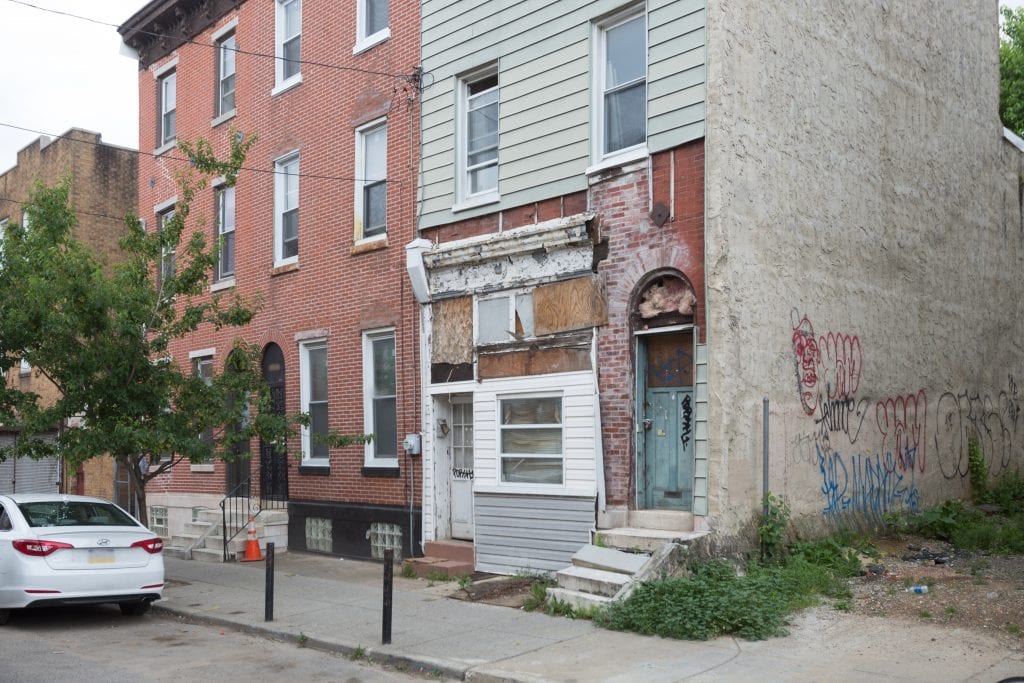
This brick rowhouse in Philly appears to have water infiltration issues from the boarded-up house on the right. It is quite possible that the owner will have a hard time finding enough money to repair the leaks, and the family’s health will be at risk while their home decreases in value, according to Jill Roberts of the Healthy Rowhouse Project. Photo by Thom Carroll
Karen Black had worked as a consultant for housing nonprofits in Philadelphia for years. In the world of affordable housing, familiar shorthands—like “CDCs” for community development corporations—scarcely require explanation.
But when Black convened a room of health care professionals and affordable housing developers to discuss a radical new collaboration on home preservation efforts, she quickly realized that she wouldn’t be able to take anything for granted.
“In the first meeting, someone said ‘a CDC’ and someone else said, ‘Do you mean a community development corporation?’” she recalled. “Then a health person looked up and said, ‘I thought you meant the Centers for Disease Control.’”
A city planner later admitted they thought she was referring to the city’s Community Design Collaborative, which provides low-cost architectural services.
The exchange was a prelude to the learning process behind the Healthy Rowhouse Project (HRP), a three-year-long effort to flood Philadelphia with badly needed home repair funds for lower-income residents that Black helped to organize. At the heart of this effort is a radical take on a not-so-radical idea: Treating access to home repair funds as both a health and an affordable-housing issue.
“There was emerging evidence out of Baltimore about this connection between health care outcomes and the health of someone’s home,” said Kate Houstoun, a program officer for the Barra Foundation, which invests in new approaches to anti-poverty efforts, including the Healthy Rowhouse Project. “This project had a lot of appealing ingredients.”
HRP focused on bringing together a diverse and expansive list of stakeholders to push for a common cause, groups that share broadly similar goals but may never have previously cooperated on a project. On the board today: affordable housing developers, health care experts, philanthropic foundations, insurance providers, hospital representatives, city officials, and others.
The collaboration has already yielded some big returns. Philadelphia’s City Council pushed through a realty transfer tax increase last year aimed at funding a $100 million bond for repair subsidies and, hopefully, to underwrite lending for home improvement loans. The long-term goal of the HRP project is to put money into rehabbing affordable rental housing and prove that insurance providers can profitably leverage their own capital for home repairs—potentially realizing millions in health savings in the process.
“Housing is a big issue for us. Not just access, but also quality. It’s a driver of many other issues,” says HRP board member Joanne McFall, market president at Keystone First, Pennsylvania’s largest Medicaid insurance provider. “In the long run, health insurers may be interested in being one source of funding for repairs, where that makes sense.”
To Jill Roberts, HRP’s director, progress thus far is a testament to what aggressive collaboration and networking can accomplish.
“The ability to control your own health and housing is so important,” says Roberts. “Everyone gets it. The city gets it. Health systems get it. You see the stories about super-users at hospitals. You see stories about people’s homes being filled with lead or causing asthma. But no one was tying the two together.”
A Landscape for Change
In some ways, Philadelphia is the ideal city for a project aimed at supporting low-income homeowners.
Fifty-six percent of residents own their homes and about 38 percent of those homeowners are counted as low-income households, larger shares than in any other big city, except Detroit. Housing is ancient, by American standards, with 40 percent of the homes more than 70 years old. In many high-poverty neighborhoods, like large swaths of North and West Philadelphia, the typical house was constructed over a century ago.
The form of the rowhouse itself is partially responsible for the city’s elevated levels of homeownership and the viability of the project. Unlike the Motor City, and virtually every other metropolitan area, most Philadelphians own relatively modestly sized attached homes, as opposed to apartments or detached housing.
We saw people who were going to lose their home because they couldn’t afford a $5,000 roof repair. That shouldn’t happen.
“I live in a rowhouse and I think it’s one of the most effective housing systems ever,” Roberts said. “Many people want to own their own homes and stay in their homes. Philadelphia is a place where you can own your home and stay in your home, even if you don’t make a lot of money.”In the sprawling early industrial hub, 19th-century developers took advantage of the city’s ample, flat terrain to stamp out block after block of rowhouses around factories. Today, detached homes and apartment complexes make up less than a quarter of the city’s housing stock, brick rowhouses dominating nearly every other unit of housing. Only Baltimore and Washington, D.C., both about half the size of the Quaker City, come anywhere close.
In short, many impoverished Philadelphians are saddled with aging rowhouses, for better or worse. Ravaged by deindustrialization and middle-class flight decades ago, most zip codes have never rebounded. The upside is that residents are spared the stresses of surging real estate prices. The downside is that this crumbling housing has the potential to add to the city’s growing affordability problem in a different way—maintenance costs.
Altogether, roughly 125,000 homeowners may be in danger of losing their homes due to unaffordable maintenance costs. Meanwhile, the waiting list for public housing in Philadelphia is already over 100,000 applicants long—and getting longer.
There are also other factors that buffeted the project before a single meeting had been called. The city is home to several major hospitals and insurance companies, which had become subject to new Affordable Care Act (ACA) rules that encourage providers to seek cost savings by addressing the root causes of illnesses. These policy shifts came about as more evidence showed stronger links between housing conditions and chronic health problems.
Meanwhile, stories about the high cost of constructing new affordable housing in Philadelphia were hitting local papers. A single unit of new affordable housing could run upwards of $300,000. On the other hand, “basic systems repair”—the essential roof, electric and plumbing maintenance needed to make rowhouses habitable and healthy— starts in the low thousands, with repair costs averaging around $12,600. With only two external walls and fewer internal features than a multistory apartment building, rowhouses are relatively simple systems.
Yet the waiting list for basic repair grants from the city was some 7,400 applicants long—and those were only the people who had actually learned that they qualified for assistance programs. More recently, this $11 million annual program has been imperiled by proposed cuts to federal Community Development Block Grants. Nonprofit developers and city officials were already looking for ways to replenish a dwindling amount of housing dollars, especially for lower-cost maintenance efforts.
“We saw people who were going to lose their home because they couldn’t afford a $5,000 roof repair,” says Roberts. “That shouldn’t happen.”
It was this landscape that Black, the lawyer-turned–nonprofit consultant, entered in 2014.
The Collaborative Process
Black had worked to set up the Philadelphia Land Bank, a program to acquire a large portion of the city’s 40,000-odd vacant properties for strategic reuse as market-rate and affordable housing. The Oak Foundation, which supports a variety of international philanthropic efforts, approached Black after the land bank’s successful launch to discuss funding new strategies to support affordable housing in Philadelphia.
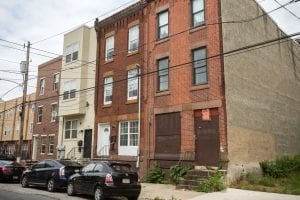
Photo by Thom Carroll
At a private meeting, Black linked recent changes to the ACA and the city’s bubbling housing market. Insurers like Keystone First had already begun a practice of sending out “community health navigators” to thousands of patients’ homes to look for housing conditions that could exacerbate heart disease, asthma, or other afflictions—conditions such as poor ventilation or insulation, black mold, leaky roofs, or deteriorated carpeting.
“We concluded that efforts needed to be focused on repositioning Philadelphia’s rowhouses as a potential asset to the city and to its families,” says Amanda Beswick, the Oak Foundation’s housing and homelessness director. “Repair programs represented good value for money and would lead to improvements in health.”
The initial grant enabled HRP to develop a “rowhouse charter,” which Beswick described as a set of goals and principles that could be used to rally support from other interested groups. The charter laid out a vision of increased home repair funding, new home improvement loans, a referral system between health care providers and repair funds, support for tenants’ rights, and more.
The Design Advocacy Group (DAG) was an early signatory. Historically focused on lobbying for better urban planning and architecture practices locally, DAG representatives were already looking for ways to “get into more neighborhoods,” according to board chair Kiki Bolender. Black and Bolender had worked on the land bank together, and Black’s pitch for a project combining health and affordable housing struck a chord with Bolender.
“I remember [Deputy Mayor] Alan Greenberger said [in 2013] that home repair could be used as inoculation against gentrification and I sat bolt upright in my chair,” she recalled. “You think about a new development going in and these shiny new apartments and then you see your most valuable possession deteriorating around you and even if you wanted to fix it up you can’t find a way.”
DAG’s nonprofit Center for Architecture (CFA) would act as the initial home for early stages of the project. Another key turning point came with financial support from the Barra Foundation, which has ties to many major institutions of higher education and health providers in Philadelphia.
The funding would allow the group to hire staff members like Roberts and form a real budget. Kate Houstoun, Barra’s program officer, said she was attracted to the project’s innovative take on affordable housing.
“We don’t see ourselves as a health funder but a group that provides funding to places that are trying something new,” said Houstoun. “Some funders have a more direct hand in the development of projects, but we view our role as that of risk capital. It was helpful to them to have local funders . . . before they went to City Hall and others, so they could say ‘Yes, we have people who were interested in this.’”
But bringing in actual stakeholders from the local health care community took a little more doing. At an early meeting at the CFA, board member Liz Hersh, a homeless-services director for the city, spoke about the need to clarify whether the project was going to focus on a “people-based” or “place-based” approach.
For doctors who deal with patients day in and day out, everything is “people-based.”
“In the community development world, it’s very common to look at people-based solutions versus place-based solutions. But it really didn’t come up for our health professionals,” said Black. “They were so used to treating people that the idea that it was also important to treat the place they live to help patients realize better outcomes was a little new.”
Ultimately, several major hospitals and insurers in Philadelphia were intrigued.
“Doctors have maybe a few minutes with a patient. They can’t always do the deep dive and say, ‘Why do I keep seeing this kid with asthma?’” said Roberts. “I think that made the project appealing.”
Today, many involved in the project recall that the pieces needed to fuse housing and health care were already there. It took a collaborative process to help people see it.
Keystone First insures some 425,000 individuals in Pennsylvania, 230,000 of whom reside in Philadelphia and half of whom are children. The year HRP began, Keystone had already begun working with the Children’s Hospital of Philadelphia to dispatch staff to assess housing conditions at patients’ homes in order to cut down on repeat visits. The state’s largest insurer, Keystone, came on board the HRP in part for the possibility of broadening and streamlining that system across the many care providers it works with.
“One of the roles we play is that of the convener. We know and work with all these different community-based and provider-based organizations,” said Keystone market director Joanne McFall.
But again, the collaborative process revealed room for improvement. At another initial meeting, a hospital program director noted that staffers were already visiting a thousand homes a year to check on environmental conditions. But when developers on the HRH advisory board asked what type of building data was being recorded at these visits—say, the presence of black mold or carpeting that could exacerbate asthma—they were met with blank stares.
“I think one of the best things that could happen would be more opportunity for information to be shared in automated ways instead of manually. When folks are identified [for home visits] and referred [for home repair funds], it’s a very manual process,” Fall said.
With broadened investment, an increasingly influential board, and real goals for improving housing and health outcomes, Black and Bolender turned to City Hall. With a race to succeed Mayor Michael Nutter in 2015 as a major leverage point, the pair wanted to extract lasting commitments from candidates to become the city’s next executive.
To Black’s surprise, “the mayoral candidates all got it.” Both privately and in public forums, every single candidate signed on.
“The city has had a housing stabilization program for about 25 years and has kept funding to that program relatively level even as our federal housing funding has seen significant cuts,” says Philadelphia Mayor Jim Kenney, who described himself as an advocate for the Health Rowhouse Project. “In addition to stabilizing homes, this program is an opportunity for many small, often minority-owned contractors to work with the city. We appreciate that there are advocates in Philadelphia like the Healthy Rowhouse Project.”
But the biggest win has been securing a council vote authorizing a 0.1 percent increase to Philadelphia’s realty transfer tax specifically to fund home repairs. Boleander said that both political successes speak to Philly’s often deeply neighborhood-oriented politics.
“[Council members] will talk about going to ribbon cuttings for affordable housing developments for 40 new units that are on a waiting list. Residents would come up to them and say, ‘What can you do for me?’” Bolender said.
Moving Forward
Perhaps more than any other factor working in HRP’s favor, backers agreed that having a neutral party like Black to identify and organize interested groups and shuttle between participants was integral.
“Having an independent person to do the collaborations here was the key,” says Houstoun. “You have to have a person to understand the true motivation of every partner.”
Beswick agreed. “The energy, commitment, knowledge, and connections of Jill [Roberts] and Karen [Black] were key. This sort of leadership is invaluable in bringing about change,” she said.
Crumbling housing has the potential to add to the city’s growing affordability problem . . . roughly 125,000 homeowners may be in danger of losing their homes due to unaffordable maintenance costs.
Roberts, who now serves as the fulltime HRP director and “convener-in-chief,” said other cities looking to emulate Philadelphia’s home repair advocacy model should start by trying to identify that neutral party—whoever they may be.
“As a consultant, [Black] does a great job of bringing disparate groups together,” she says. “I think having that person is important, but I also think that person can look like a lot of different people. It could be an elected official, a consultant, an activist, or just someone with a deep knowledge of these issues.”
Although the tax supporting it has been approved, a bond that would underpin some $100 million in repair funds has not yet been voted on by the city council. Of that $100 million, some $40 million aimed at underwriting increased private lending for home repairs is still being worked out.
That’s the big prize for the HRP.
“The national denial rate for home repair loans is 37 percent. The denial rate in Philadelphia is 62 percent,” Bolender said.
The ultimate goal, of course, is to leverage ever more private capital to ease the burden on public resources. Fortunately, the nature of housing as an issue means there is still a lot more room to expand the appeal of HRP to interested foundations, funders, and other new stakeholders. Substandard and vacant housing has been linked to increased crime and decreased home values, not to mention the historic preservation potential of stabilizing tens of thousands of hundred-year-old extant housing units.
“It’s small ‘P’ preservation. It’s not Independence Hall. But if you take the rowhouse as an aggregate asset, that’s hugely important to the city,” said Bolender. “These are the kinds of neighborhoods ordinary people live in.”

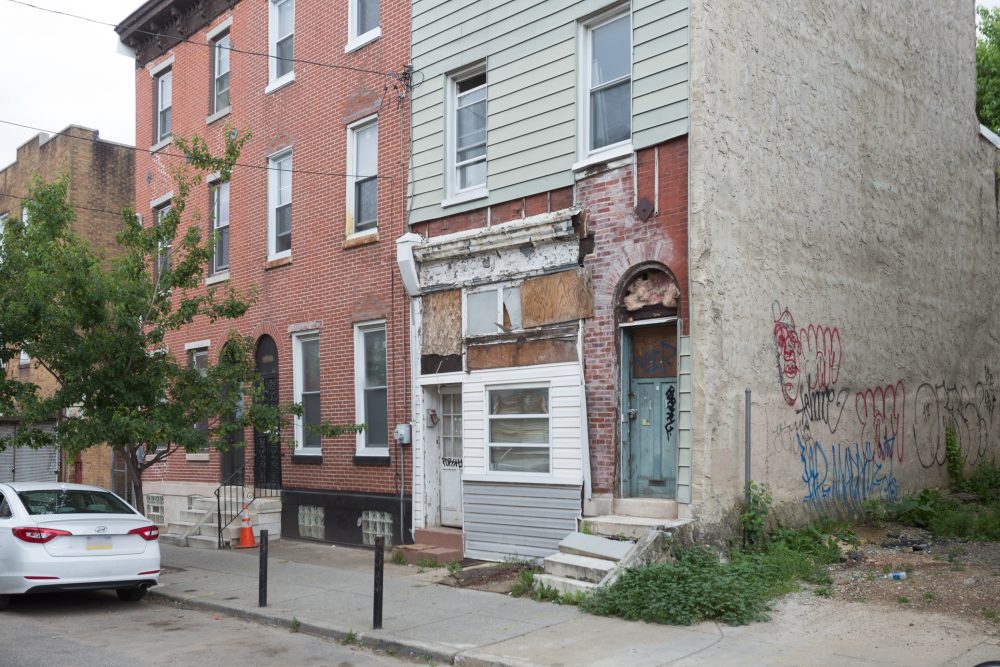

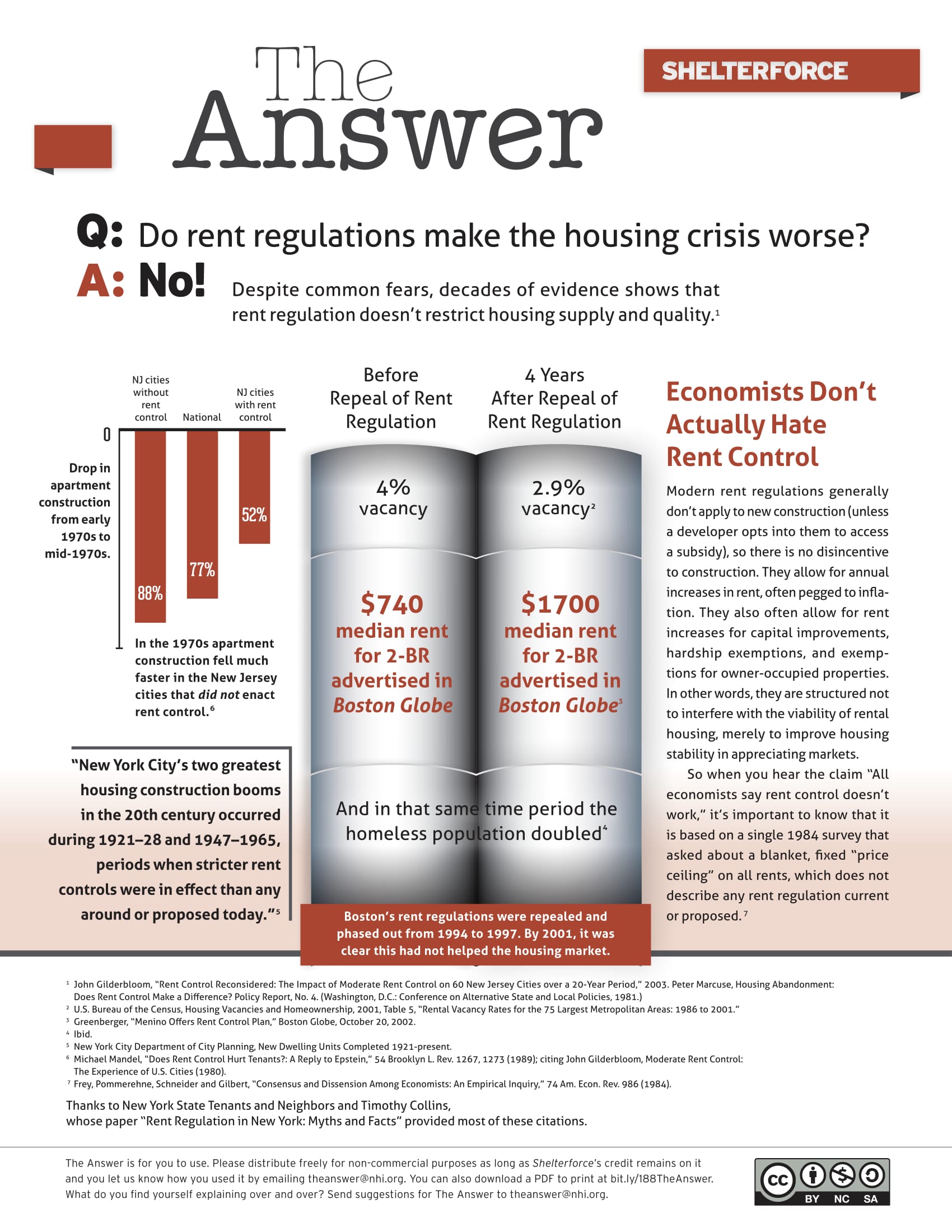

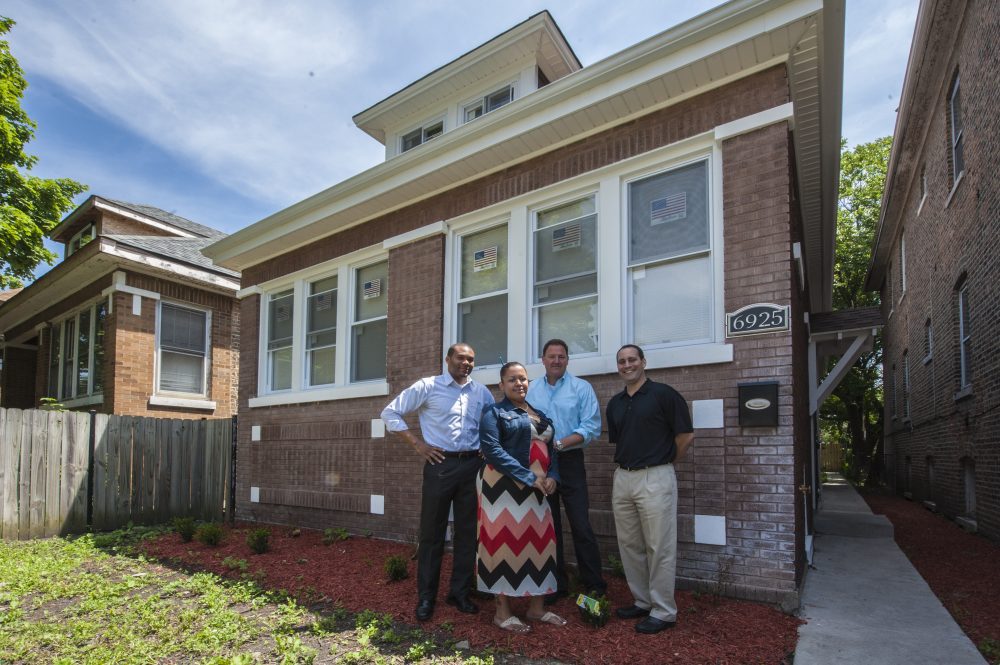
Hi Ryan: Those bills to float the bonds have indeed passed Council and been signed by the Mayor. Bill No. 161014 passed 12/8/16 and authorizes the $60m bond for the grants, and Bill No. 170878 passed 11/30/17 and authorizes the $40m for loans and a service agreement with PRA on the loan program. I don’t know whether the bonds have actually been floated or not; I suspect the $60m has but the $40m has not.
Thanks for the update, Beth! (This article was originally published in the fall, in our print issue, we were just giving it a boost in the Weekly this week.)
I live in a Philadelphia Neighborhood with enormous potential, historical homes and civic resilience but its riddled with vacancy. Residents are low income and struggle to maintain their homes. I’ve seen people abandon their homes because they can no longer afford repairs. This leads to speculators buying up properties and sometimes allowing them to just sit or rehab them (sometimes poorly) for rent. But, Often neighbors living next door to abandoned properties are further burdened because of all the ills (decrease market value, water damage, insurance issues, etc.) associated with the neighboring abandoned property. The whole community has been impacted by this blight.
The waiting list for home repair grants is unbelievable and too many people find themselves in emergency situations. Philly is not doing a good job of providing assistance for home repairs for residents incrisis. I see far too many residents struggling with home maintenance.
Dear Joyce, may I ask which neighborhood? The preservation aspect, and community resilience otherwise social infrastructure are both along others core assets necessary towards the possibility of a targeted revitalization initiative.
Having lived here in late 80s through mid 90s and returning back in 2017, I find row homes are just out dated. They remain affordable due to low levels of poverty based on neighborhoods. The houses are small, one bath and maybe an additional half. The kitchens and bedrooms lack sufficient space for modern sized furniture and appliances. I still visit homes with aged carpet and baths. The halls are narrow and closets are unaccomadating. Good for the 20-30s but not for today.